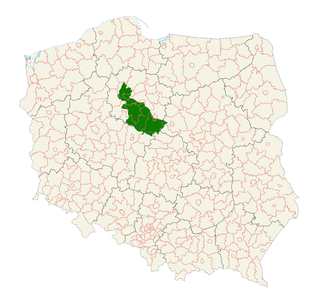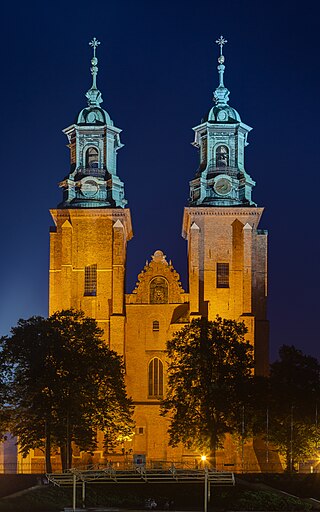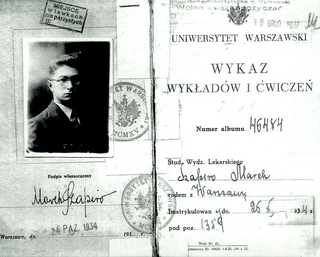Related Research Articles

Kuyavia, also referred to as Cuyavia, is a historical region in north-central Poland, situated on the left bank of Vistula, as well as east from Noteć River and Lake Gopło. It is divided into three traditional parts: north-western, central, and south-eastern.

Krzysztof Jerzy Wielicki is a Polish alpine and high-altitude climber, regarded as one of the greatest Polish climbers in history. He is the 5th man to climb all fourteen eight-thousanders and the first ever to climb Mount Everest, Kangchenjunga, and Lhotse in winter. He is a member of The Explorers Club.

Wanda Rutkiewicz was a Polish mountain climber and computer engineer. She was the first woman to reach the summit of K2 and the third woman to summit Mount Everest.

The Brześć Kujawski Voivodeship was a unit of administrative division and local government in the Kingdom of Poland, from the 14th century to the Second Partition of Poland in 1793. It was part of the historic Kujawy region and the Greater Polish prowincja. Originally, its name was Brzesc Voivodeship, but after the 1569 Union of Lublin, it was renamed into Brzesc Kujawski Voivodeship, to distinguish it from Lithuanian Brest Litovsk Voivodeship.

Duchy of Masovia was a district principality and a fiefdom of the Kingdom of Poland, existing during the Middle Ages. The state was centered in Mazovia in the northeastern Kingdom of Poland, and during its existence, its capital was located in the Płock, Czersk and Warsaw. It was formed in 1138 from the territories of the Kingdom of Poland, following its fragmentation, that was started by the testament of Bolesław III Wrymouth. The country existed in the years: 1138–1275, 1294–1310, 1370–1381, and 1495–1526, between that time, going through fragmentations of its territory into smaller duchies and its unification. The states formed during its fragmentation were duchies of Kuyavia, Dobrzyń, Czersk, Płock, Warsaw, Rawa and Belz. In 1526, the country was incorporated into the Kingdom of Poland.

The Archdiocese of Gniezno is the oldest Latin Catholic archdiocese in Poland, located in the city of Gniezno. The ecclesiastical province comprises the suffragan dioceses of Bydgoszcz and Włocławek.

The Centennial Hall, formerly named Hala Ludowa, is a historic building in Wrocław, Poland. It was constructed according to the plans of architect Max Berg in 1911–1913. Max Berg designed Centennial Hall to serve as a multifunctional structure to host "exhibitions, concerts, theatrical and opera performances, and sporting events". The hall continues to be used for sporting events, business summits, and concerts.
Zbigniew Klemens Karpus is a Polish historian. Professor of Nicolaus Copernicus University in Toruń, where he is the director of Institute of International Relations, he is the author of several books and dozens of articles. He specialized in the relations between Poland and her eastern neighbours.

Stanisław Ryniak was a Polish political prisoner of Auschwitz concentration camp during the Second World War. He was the first Polish prisoner in Auschwitz.
Konger is a Polish performance art group from Kraków, Poland, established in 1983 by a group of professional artists in protest against the imposition of Martial law in Poland. The artists boycotted all state galleries and took up performance art instead, an obsolete medium in the eyes of the official art critics.

Ghetto benches was a form of official segregation in the seating of university students, introduced in 1935 at the Lwów Polytechnic. Rectors at other higher education institutions in the Second Polish Republic had adopted this form of segregation when the practice became conditionally legalized by 1937. Under the ghetto ławkowe system, Jewish university students were required under threat of expulsion to sit in a left-hand side section of the lecture halls reserved exclusively for them. This official policy of enforced segregation was often accompanied by acts of violence directed against Jewish students by members of the ONR.

Kujawy is a village in the administrative district of Gmina Strzeleczki, within Krapkowice County, Opole Voivodeship, in south-western Poland.

Treaty of Radnot was a treaty signed during the Second Northern War in Radnot in Transylvania on 6 December 1656. The treaty divided the Polish–Lithuanian Commonwealth between the signing parties.
Zdzisław Bubnicki was a Polish scientist, a specialist in the fields of automation and computer science. His main scientific interests concerned: decision theory, control theory, system identification, pattern recognition, expert systems, and knowledge-based systems, complexes of operations, and methodology of computer systems.

National costumes of Poland vary by region. They are not worn in daily life but at folk festivals, folk weddings, religious holidays, harvest festivals and other special occasions. The costumes may reflect region and sometimes social or marital status.

The Duchy of Inowrocław was one of the territories created during the period of the fragmentation of Poland. It was originally part of the Duchy of Kuyavia, but was separated by Ziemomysł and Władysław I the Elbow-high, upon the death of Duke Casimir I in 1267.

Janusz C. Szajna - Polish entrepreneur, scientist and university professor. He contributes to the field of computer science, including advising the 'Commission for Digitization, Innovation and Modern Technologies' of the Polish government.

The Warsaw rectifier is a pulse-width modulation (PWM) rectifier, invented by Włodzimierz Koczara in 1992.

Piotr Antoni Steinkeller ; 15 February 1799 - 11 February 1854) was a Polish entrepreneur, banker and pioneering industrialist. He was known as the "King of Zinc" and opened the London Zinc Works in Hoxton in 1837.